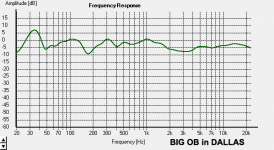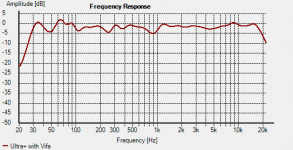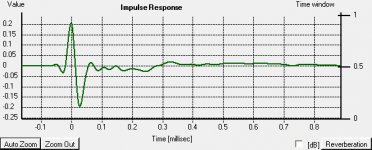In rooms that are problematic for bass, a semi-open baffle with equalization can work pretty well in my limited experience. I designed an equalizer for one for a friend that used a big major-motored (Aurasound custom) 15" on each side, with biamping and a simple crossover for the mid-high, a lot of boost for the woofer. It sounded pretty decent to my ears. The power requirements for the woofer were substantial, although this guy didn't like to listen all that loud, so it worked for him.
Oh, OK. No worries. They may not be to your taste. I certainly enjoy the good ones.
No problem, to each his own.
I must also add that I have never heard a decent OB project worth mentioning, so I have nothing in my experience to compare it with. If I did hear a well made project, I might change my mind, who knows.
Dvv you are right to say all of that . When people made good box speakers for most it was a dream come true . The love of music would be allowed inside the house . Bookcase speakers summed it up . I have even heard them in bookcases and enjoyed an evening of music with them looking like a 1960's advert . Like the Concorde it is easy to say OB is just a daft idea belonging to 1954 ( Fairey Delta 2 , least high spec plane of WW2 the Swordfish , and then !! ) . Concorde had to do some weird stuff to fly .The Boeing 747 is a remarkable aircraft . Better than the Concorde commercially no doubt . Is going slow better ?
I do think 330 Hz up is a practical OB frequency . It will at worst make for a cheaper speaker . Added to transmission line with slight under damping down to 25 Hz might be very OK . The Boffle idea also looks possible ( many baffles with holes in with open back ) .
mh-audio.nl - Home
I do think 330 Hz up is a practical OB frequency . It will at worst make for a cheaper speaker . Added to transmission line with slight under damping down to 25 Hz might be very OK . The Boffle idea also looks possible ( many baffles with holes in with open back ) .
mh-audio.nl - Home
Brad, what is a semi-open baffle? Is that perhaps a box with no back panel, i.e open at the back?
I know of a guy swearing this type of speaker can outplay standard all closed types of boxes.
Yes, essentially. The guy of course touted the thinking "outside the box".
It's funny, actually. I rolled an EQ box in a couple of days that sounded great, using Toshiba dual FETs for the highpass and a decent opamp for the low frequency boosted outputs, then set to work on a tube-solid state hybrid design. The low frequency boost required was so great that tube excess noise was terrible, although you really couldn't hear it most of the time. The highpass for the mid-high drivers was done with 6C45 cathode followers with current sources and was very quiet indeed. The problem was, after packaging in a single box, the huge Audio Note copper foil/paper/oil output coupling caps were sufficient pickup loops for the residual field from the power supply toroid, such that the hum level was unacceptable. That was about where the development stopped.
I've tried bass boost and EQ for OB with limited satisfaction. A big inductor for a 1st order low pass - or add a cap for a staggered 2nd order, that always sounds much better to me.
You can easily lose 10dB in the bass from the open baffle losses, so the midrange needs to be brought down. There's a good reason why we put woofers in boxes, but OB can sound marvelous if you are willing to deal with the size and efficiency sacrifices.
You can easily lose 10dB in the bass from the open baffle losses, so the midrange needs to be brought down. There's a good reason why we put woofers in boxes, but OB can sound marvelous if you are willing to deal with the size and efficiency sacrifices.
Don is an apostle of simplicity, except in this case two amplifiers per channel were assumed necessary. I doubt that it is very practical with a single amp and passive crossover networks.I've tried bass boost and EQ for OB with limited satisfaction. A big inductor for a 1st order low pass - or add a cap for a staggered 2nd order, that always sounds much better to me.
You can easily lose 10dB in the bass from the open baffle losses, so the midrange needs to be brought down. There's a good reason why we put woofers in boxes, but OB can sound marvelous if you are willing to deal with the size and efficiency sacrifices.
The amount of baffling for the woofers was sufficient to allow a 6dB/octave bass boost, to about 30 Hz, to sound pretty decent, although as mentioned he doesn't listen at particularly high levels, which would push the required amplifier power into the few-kilowatt region, and still not satisfy bass freaks. The woofers were not stock in some important ways, and were tailored to the quasi-open-baffle approach. He must still have a big pallet of them stored somewhere.
The crossover to the mids and tweets was also just a one-pole highpass, which places quite stringent requirements on the low-frequency handling of those mid drivers.
The system did seem to be far less critical of room positioning than many, but I didn't have a chance to experiment very much. People who heard it in Europe commented that he'd made something that sounded almost as good as electrostats --- which if you like 'stats, I guess you would like.
Or just make your baffle bigger. There is no substitute for size here. 30 Hz is not an option but getting the cancellation frequency down has a major benefit in both extension and output. Extra plywood is also cheaper than more drivers. But it needs to be braced or its still another diaphragm radiating.
If you are willing to equalize using a smaller box with a robust driver and eq you will also get good results. If the woofer is used exclusively below the resonances of the box panels (and the system resonance) you avoid their potential impact on the sound.
If you are willing to equalize using a smaller box with a robust driver and eq you will also get good results. If the woofer is used exclusively below the resonances of the box panels (and the system resonance) you avoid their potential impact on the sound.
One opportunity I have is to use my 8 watt SE valve amps in a really nice way if I make a good job of this OB design . The 12 inch mid-range will be their duty to drive ( 8 watts 1 % THD , no loop feedback ) . 98 db / Watt .
The bass I recon requires 20 db more power . If I use a series resistor perhaps 26 dB . Hey ho I need 160 watts . With luck a series resistor and shunt capacitor might equal an inductor if I get lucky . With a 10 R load the amp won't care too much . An H bridge of 2N3055's would be OK . At 250 Hz bandwidth I imagine they will be as good as it needs . I fancy a double VAS driving the bridge , it seems very economical to do that ( never seen it done ) . MJ11015/6 are very OK 4 MHz 30 A ? ( 3 diode biasing , good enough for LF ) . Now that would be simple and rather nice slewing , the VAS's would be forced to be symmetrical as the load is identical . I imagine feedback could be from one side . with 10 R in the way I imagine SOA will not be a problem ? The drive unites claim 200 Watt ability ( RMS ) . If it works I would try converting the amp to a power active filter . Still retain 10 R to encourage Fs exaggeration . A subsonic filter I feel is needed ( switchable , party mode and LP's ) .
I had the opportunity to hear my valve amps against a vastly expensive 300 B amp . It's owner and I liked mine , much more bass . To be honest with you I am as ambivalent as Mr Dvv about valves . I have a feeling they will be right for this job .
I would like to make a phase plug for the 12 LTA's . That seems a nice hour on the lathe at Loricraft Audio . Woodwork also , I might get a bit of help . They would do well to have some speakers like this .
OB sound boards . Big problem that's for sure . MDF + Ply is hoped to work .
The bass I recon requires 20 db more power . If I use a series resistor perhaps 26 dB . Hey ho I need 160 watts . With luck a series resistor and shunt capacitor might equal an inductor if I get lucky . With a 10 R load the amp won't care too much . An H bridge of 2N3055's would be OK . At 250 Hz bandwidth I imagine they will be as good as it needs . I fancy a double VAS driving the bridge , it seems very economical to do that ( never seen it done ) . MJ11015/6 are very OK 4 MHz 30 A ? ( 3 diode biasing , good enough for LF ) . Now that would be simple and rather nice slewing , the VAS's would be forced to be symmetrical as the load is identical . I imagine feedback could be from one side . with 10 R in the way I imagine SOA will not be a problem ? The drive unites claim 200 Watt ability ( RMS ) . If it works I would try converting the amp to a power active filter . Still retain 10 R to encourage Fs exaggeration . A subsonic filter I feel is needed ( switchable , party mode and LP's ) .
I had the opportunity to hear my valve amps against a vastly expensive 300 B amp . It's owner and I liked mine , much more bass . To be honest with you I am as ambivalent as Mr Dvv about valves . I have a feeling they will be right for this job .
I would like to make a phase plug for the 12 LTA's . That seems a nice hour on the lathe at Loricraft Audio . Woodwork also , I might get a bit of help . They would do well to have some speakers like this .
OB sound boards . Big problem that's for sure . MDF + Ply is hoped to work .
Yes, quite a good idea, actually. It is a problem and to do well you have to pay attention to it. Thick composite baffles help, as does decoupling the woofers.Have you OB guys any idea how much noise the reaction forces of the drivers create?
But don't forget, boxes sing, too. And they have at least 5 surfaces exposed to the air.
Below you'll see 2 FR charts from open baffle speakers. These are in-room at the listening position, real world. Not 1M near field anechoic. One is at an audio show, the other in my room at home, but different speakers. The 5dB drop above 1.5K is done on purpose for voicing. I ended up doing the same for mine when going passive - it works.
Attachments
Yes, I'm a great fan of stability of speakers, I always find it hilarious to see things like high powered PA type speakers sitting on top of a milk crate or equivalent ...Have you OB guys any idea how much noise the reaction forces of the drivers create?
OB's are pretty much sound boards, and like with piano's, you don't need very large excursions to drive sympathic resonances.
My first serious attempt at getting better sound from a conventional, rather small bookshelf, decades ago revolved around making it have effectively huge mass. Lo and behold, powerful, intense, "fast" bass, huge soundstage - going elsewhere and listening to 'big momma" speakers, with mega woofers, etc, then was laughable - the latter sounded so silly ...
Not 1M near field anechoic.
You consider 1M to be "near field anechoic"?
Thinking about it the sounding board might be the best of a bad job . Spencer Hugues told me that you will fail to make any box ridged . 1.5 kHz if you tried . That would be exactly where you don't want it to be . Ideally 40 kHz . His answer was let it flap and then damp it . Spendor BC1 , Lockwood , Klipsche . Spencer said try for subsonic as that is easier than 40 kHz . Apparently when he told me that it was a special trip to see me . I was the last person he visited outside of the family and friends according to Derek his son . To be honest I haven't met anyone since then who made it so easy to understand things . I was a little lad who phoned him for advice on many occasions . I have to be honest I liked KEF 104 AB more ( 104 even more than AB ) . When no one could sell 104's or BC1's due to the Flat Earth people ( Linn , Rega , Naim , Nytech ) I sold loads . Monitor audio 352's also . Robin designed them who inspired these baffles . Prior to Robin it was Martin Colloms ( MA 1 's ) . 352's approximately were to BC1 + 8 x 4 plank of wood principles . 352 better than EPOS ES14 ? I think so .
You could be forgiven for thinking Spencer to be some amateur speaker designer if you met him or aged unknown Spitfire pilot . He found very simple reasons why things didn't work . So simple that some might have said his IQ didn't match the task . That isn't an IQ problem , that's modesty . If you have BC1's I would suggest a baffle experiment . You have no idea how good the BC1 units are if in a box . If Prelude's even better as that was Spendor using up BC3 bass units . 90 db / watt is not to be sniffed at . Derek's first design when dad was at the end . Derek said the Audax is a difficult tweeter . Sounds great in Preludes . Actually Prelude's are great . Everyone should have a pair or Dynaco A25's .
You could be forgiven for thinking Spencer to be some amateur speaker designer if you met him or aged unknown Spitfire pilot . He found very simple reasons why things didn't work . So simple that some might have said his IQ didn't match the task . That isn't an IQ problem , that's modesty . If you have BC1's I would suggest a baffle experiment . You have no idea how good the BC1 units are if in a box . If Prelude's even better as that was Spendor using up BC3 bass units . 90 db / watt is not to be sniffed at . Derek's first design when dad was at the end . Derek said the Audax is a difficult tweeter . Sounds great in Preludes . Actually Prelude's are great . Everyone should have a pair or Dynaco A25's .

This is how I sent it to a friend who would not read through a page like this I suspect . The 405 is any big power amp , I might borrow a 405 or C-Audio . I plan > 160 watts . The NAD will do to get it going . It could power the mid if wanted . The valve amp is one I know that if equipped with better valves is cheap and good , I will use my own .
The diagram is the first attempt to visualize the idea . The mid unit is not placed like that for stereo . It is to attempt to put problems in the best compromise . I have no idea of best placements yet . I need more data .
Thanks. But I didn't post anything before.Pano, the in room response is now looking rather impressive, not at all like the first few graphs you posted.
The graph with the green line is: 2x18", 1x10", 1x dome tweeter.
The graph with the red line is: 2x15", 1X3" fulrange.
No EQ, other than the passive crossover itself. Acoustic crossover point from 18" woofers to mid is 200Hz, from 15" woofers to fullrange about 300Hz.
Baffle are approx 2 feet x 4 feet with shallow wings. A little bit bigger for the dual 18", IIRC.
A similar response can be had with a single woofer, tho efficiency and dynamics suffer. I also feel that 2 woofers per side sounds better, more at ease.
- Status
- Not open for further replies.
- Home
- Member Areas
- The Lounge
- Sound Quality Vs. Measurements


